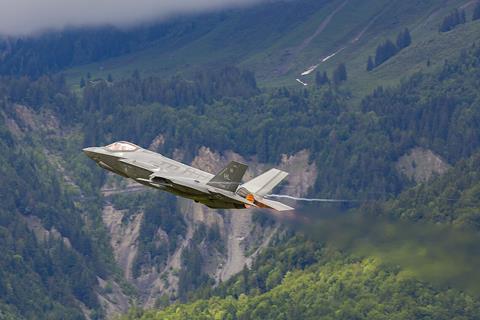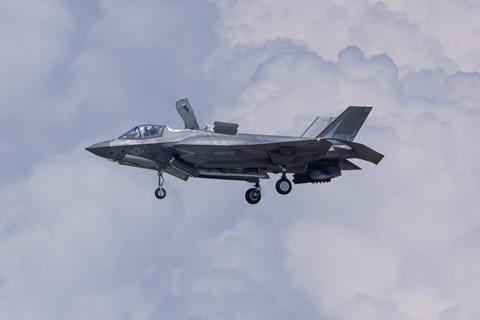Engine maker Pratt & Whitney (P&W) will soon receive a contract to begin upgrading the F135 engine that powers Lockheed Martin F-35 stealth fighters.
The US Department of Defense (DoD) on 27 November said it plans to issue a sole-source award to P&W for the F135 Engine Core Upgrade (ECU) package, which aims to boost the electrical output and cooling capacity of the current engine.

“The anticipated contract actions will provide F135 ECU design maturation, test article manufacturing and development, test asset procurement, validation and verification activities, weapon system integration for air system capabilities, test equipment procurements, and developmental hardware procurements for the F-35A, F-35B and the F-35C variants,” the Pentagon says in a solicitation announcement.
Naval Air Systems Command will oversee the development and rollout of the ECU package, which will be fielded to F-35s of all US military operators.
The Pentagon plans to begin issuing contracts to P&W in the first quarter of 2024, with the fleet-wide upgrade programme completed by 2031.
Although the DoD issued a $66 million contract in July to support ECU design maturation and long-lead material acquisition, the sole-source contract announcement solidifies P&W’s position as F-35 propulsion supplier.
“We’ll complete preliminary design work on the F135 Engine Core Upgrade in December, and we are ready for the official preliminary design review, which is scheduled in January 2024,” says Jennifer Latka, P&W vice-president for the F135 programme.
The F-35 engine improvement programme aims to address a projected shortfall in electrical power and onboard cooling capacity. Improvements to the advanced jet’s sensors, avionics and weapon systems have pushed the F135 engine to operate outside of original design parameters.
With the forthcoming Block 4 upgrades, projected to require even more electrical power and cooling from the engine, the Pentagon has been looking for a solution to boost the F-35’s onboard capacity.
“Pratt & Whitney has 600 employees fully dedicated to this effort, and we’re on track to deliver F-35 operators the power needed to enable Block 4 capabilities and beyond starting in 2029,” says Latka.
The 27 November contract announcement says the final ECU design must provide at least double the current system demand for air cooling.
The ECU modernisation package from P&W beat out a competing proposal from GE Aerospace, which had offered an entirely new engine for the fifth-generation stealth fighter.
Developed under the US Air Force’s Adaptive Engine Transition Program (AETP), GE’s XA100 adaptive-cycle engine promised substantial improvements to thrust and fuel efficiency, in addition to the desired power and cooling capacity.

However, concern about the cost of fleet-wide engine replacements, combined with a lack of compatibility with the short take-off and vertical landing F-35B, led the Pentagon to opt for P&W’s ECU.
“It is critical the F135 ECU be common across the F-35A, F-35B and F-35C variants,” the DoD confirmed in the ECU contract announcement.
The ECU package will be available to overseas F-35 operators through the DoD’s Foreign Military Sales process, although no foreign customers have yet committed to purchasing the hardware upgrade.
In addition to boosting the F135’s power and cooling capacity, the Pentagon has also mandated that the ECU programme improve overall F135 engine life and improve the vertical lift capability of the F-35B.
One aspect of the F-35 upgrade that remains outstanding is how to improve the onboard power and thermal management system (PTMS) that works with the F135 engine to cool electronics and produce electrical power.
The current Honeywell-made PTMS will need to be upgraded, according to an audit by the US Government Accountability Office, to support additional enhancements to the F-35 beyond Block 4.
Honeywell Aerospace president of defence and space Matt Milas told FlightGlobal in August that the company is working with Lockheed to squeeze extra cooling capacity out of the current PTMS. Under a direct contract with Lockheed, Honeywell is also undertaking research efforts that aim to generate an additional 10-17kW of power.
However, rival Collins Aerospace is proposing entirely new hardware it says will provide more than twice the cooling capacity of the Honeywell PTMS. Collins unveiled its concept – the Enhanced Power and Cooling System – at the 2023 Paris air show in June.
Honeywell has criticised that proposal as unnecessarily expensive. Both Collins and P&W are subsidiaries of RTX, formerly known as Raytheon Technologies.





























